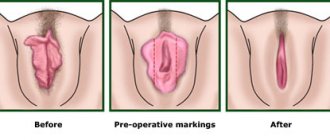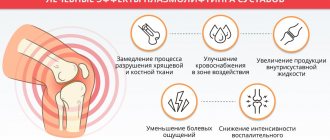For most women, sagging breasts are a serious aesthetic problem that prevents them from loving their own body and causes complexes, so the issue of treating mammary ptosis is especially pressing. Involutional aging processes, genetic predisposition and the minute-to-minute impact of the Earth's gravitational forces contribute to natural ptosis of the skin, body tissues and some internal organs. If we are talking about prolapse of the mammary glands, then in medicine it is called “ mastoptosis
" With mastoptosis, a woman’s breasts lose their elastic shape and look saggy. Special care for preventive purposes only helps to slow down the process of breast ptosis. This includes: contrast showers, massages, wraps, cosmetics, mesotherapy, biorevitalization of breast skin, as well as some other salon procedures. However, with severe mastoptosis, conservative methods are no longer effective. In this article we will talk about possible ways to treat mammary ptosis. The fastest and most effective of them is still mastopexy (mammopexy) - plastic surgery to tighten the mammary glands with or without the use of implants. But first, let’s look at why breasts sag in the first place: what factors contribute to this?
What is vertical mastopexy
Mastopexy, a breast lift procedure, is an aesthetic surgery on the mammary glands, the purpose of which is to correct the drooping of the areola and nipple, creating a full and firm upper pole. The procedure is indicated in cases of moderate sagging breasts and stretching of the areola; it involves lifting the bust without changing the volume. In addition to lifting, the procedure eliminates asymmetry and tubular deformation.
Photos "Before" and "After"
Lift with implants
See more “Before” and “After” photos
Breast lift (mastopexy): when and how this operation is performed
Table of contents
- Indications for breast lift
- Preparing for surgery
- Postoperative period
- Cost of the operation
- Advantages of carrying out the procedure at MEDSI
Mastopexy is an aesthetic operation aimed at eliminating ptosis (drooping) of the mammary gland (breast lift).
Refers to plastic surgery methods and is the second most popular among women after bust augmentation. The difference between these two interventions lies in the presence and absence of implants: an increase in volume involves the use of artificial prostheses, mastopexy is performed using one’s own tissues (although, if necessary and at the request of the patient, both methods can be combined). Mastopexy is always an invasive procedure, but the degree of invasiveness may vary depending on the degree of tissue prolapse, the presence of breast asymmetry, and the initial bust size. The criterion for dividing the methods of breast lift surgery is the type of incision.
- Circular - an incision is made around the areola, excess tissue is removed around the perimeter of the incision. The small seam at the border of the areola is almost invisible. Can be used on small breasts with grade 1–2 deformity
- In case of severe ptosis, when the gland moves to the lower part of the breast, significantly stretching it, and the areola and nipple move down, an anchor incision is used to remove excess tissue below the nipple, as well as around it, and move the areola higher. The stitches are noticeable after healing, although they become lighter and thinner over time, but their location (under the chest) allows you to freely wear open clothes
The decision on the feasibility and method of plastic breast lift is made only together with a doctor and only in the absence of contraindications.
Indications for breast lift
The presence of stretch marks and ptosis while maintaining the volume of the glands is a direct indication for a breast lift without implants. The operation will also help solve the problem of asymmetry. However, before the procedure, the doctor must help the patient make an informed decision.
Determine the degree of ptosis
The criterion is the degree of descent of the areola and nipple in relation to the submammary (submammary) fold. Normally, the areola is located at a level corresponding to the middle of the shoulder. Mastoptosis is diagnosed when it is displaced downwards:
- Up to the fold level - the first degree of deformation
- Below the fold, but the nipple is facing forward - second degree
- Below the fold and the nipple is facing down - third
- False mastoptosis - downward displacement of the glands without displacement of the areola
- Determine the size of the glands
Determine the size of the glands
It will not be possible to completely restore the lost shape of the breast to a patient with the third degree of ptosis - only correction is possible here. If the size of the glands is not too large, better results can be achieved with the use of implants.
The same is true for patients with a small bust size: during breast surgery, when lifting and removing part of the skin, the volume will be reduced by another half size, for some women this can be a strong argument in favor of using prostheses.
Lifting large breasts also presents some difficulties, since under the influence of gravity and reduced skin turgor (elasticity), the large glands will inevitably sink again, so they need to be reduced and fixed with sutures.
Determine the patient's goals and expectations
The doctor should recommend that the patient become more familiar with the topic so that in the postoperative period she does not encounter the syndrome of inflated expectations. The main thing that the patient must understand is that after pregnancy, the properties of the skin change irreversibly, and medicine is unable to return the breasts to their original appearance; one can only reduce aesthetic defects to the possible (individual for each) minimum.
Determine the absence of medical contraindications:
- Hemostasis disorders
- Immunodeficiency state
- Progressive chronic diseases
- Oncological processes
- Fibrocystic mastopathy
- Hormonal imbalances
- Diabetes
- Acute infectious diseases
- Children's age (up to 18 years)
- Acute mental or neurological disorders
Surgery should be postponed for patients planning pregnancy (the likelihood of ptosis returning is high) or those undergoing treatment for obesity (after losing weight, breast volume will also decrease).
Preparing for surgery
Since mastopexy is a surgical operation under general anesthesia, sometimes lasting more than an hour, the patient must undergo an examination to exclude the possibility of complications. It includes analyzes and hardware studies:
- Coagulogram – balance of blood coagulation and anticoagulation systems: Prothrombin, INR, Fibrinogen and APTT (the list varies slightly in different clinics). Necessary to prevent bleeding and thrombosis
- Assessment of general condition (clinical tests of urine and blood) - necessary to exclude inflammatory, allergic processes, anemia
- Elimination of blood infections (HIV, syphilis, hepatitis B and C) - for the safety of medical staff and other patients of the clinic, as well as to prevent complications that may develop in the patient in connection with these diseases
- Electrocardiography – to assess cardiac activity
When all organizational issues have been resolved, a date is set by which the preparatory period must be completed and the examination must be completed.
Direct preparation for the intervention includes:
- Quitting smoking to reduce the risk of thromboembolism - one month before surgery
- Taking vitamin and mineral complexes to prevent anemia – a month before surgery
- Stop taking oral contraceptives that increase blood clotting - 2 weeks before surgery
- Stop taking acetylsalicylic acid and other antiplatelet agents that increase the risk of bleeding - 2 weeks before surgery
- Stop eating 12 hours before surgery
- Stop drinking fluids – 4 hours before surgery
Postoperative period
The duration and nature of the postoperative period will depend on the method used to lift sagging breasts.
When strengthening large mammary glands, as well as breast prosthetics, the recovery period may last six months, and hospital stay under the supervision of doctors may increase from 2 to 7 days.
This is due to the fact that with more extensive interventions, the predicted complications (that is, those that cannot be avoided - pain, swelling, slight increase in temperature) are more pronounced and require maintenance therapy. Sometimes breast drainage may be necessary to drain accumulated lymph and blood. But most often, treatment will consist of parenteral anesthesia, preventive antibacterial and anti-inflammatory therapy, and dressings.
After discharge, the patient must follow a special regimen and take medications prescribed by the doctor for a month.
- Wear compression underwear, which ensures normal blood circulation in damaged tissues, prevents the formation of hematomas, and reduces swelling. Lingerie is selected by the clinic’s doctors according to individual parameters
- Avoid visiting saunas, swimming pools, swimming in open water, carefully observe the rules of personal hygiene and infection safety
- Avoid physical exertion on the muscles of the shoulder girdle and chest, do not lift weights
- Don't sleep on your stomach
- Maintain sexual rest
- Avoid nicotine and alcohol intake
- Continue the course of medications prescribed by your doctor
- Monitor your condition - visit a doctor at least once a week
Complications of the postoperative period occur quite rarely and, as a rule, with insufficiently conscientious care:
- Infectious complications (due to untimely or poor-quality treatment of sutures, non-compliance with the infection regimen, violation of the preventive antibiotic therapy regimen)
- Extensive hematomas (as a result of early refusal to wear compression garments)
- Difficult healing of sutures (due to improper care or concomitant pathology that was not reported to the doctor)
Symptoms requiring emergency medical consultation:
- Sudden rise in temperature above 38oC
- Bleeding
- Redness and swelling of the stitches or the entire breast, fluid discharge from the wound
Cost of the operation
It can vary significantly depending on the prices of the selected clinic, the doctor’s rating, and the list of manipulations included in the service. The total amount consists of the cost:
- Consultative appointment
- Preoperative examination
- Anesthesia
- Medicines used during surgery and in the postoperative period
- Supplies
- Hospitalizations (usually clinics have a price list establishing the amount of payment per day of stay)
- Follow-up
- Dressings and other manipulations after discharge
- Additional manipulations, the need for which arose during the operation and were not provided for (hemostatic, resuscitative)
The patient should discuss with the doctor in advance what the price list for a breast lift includes.
Advantages of carrying out the procedure at MEDSI:
- High-class specialists - leading Moscow plastic surgeons, anesthesiologists-resuscitators and nursing staff with more than twenty years of experience
- Extensive experience in managing patients after mastopexy
- Full technical equipment: modern intensive care unit and 24-hour hardware monitoring
- Own laboratory
- Comfortable hospital atmosphere, high level of service, good nutrition
- Assistance with accommodation for non-residents
To make an appointment, call 24/7: 8 (495) 7-800-500.
Will the seams be visible?
Of course, you want to lift your breasts using the periareolar method so that postoperative scars and stitches are not noticeable.
But the choice of technique and suture is the absolute jurisdiction of the surgeon. The patient must listen and trust. Both the doctor and the woman are united by one goal - to obtain the best aesthetic result.
As a result of the operation, the suture on the chest begins from the lower edge of the areola and continues to the submammary (inframammary) fold.
I urge potential patients not to worry about a noticeable seam. This is a minor sacrifice in the name of a harmonious form and, very importantly, a stable result. Postoperative sutures are successfully polished with laser devices in the cosmetologist's office.
If we decide to tighten large excess skin by collecting them and suturing only along the areola without a vertical seam, we will get the “tomato breast” effect. The excess skin will wrinkle around the areola into a rough texture. This can hardly be called a good result in the practice of a plastic surgeon.
WE ALSO ADVISE YOU TO READ: Super-light breast implants B-Lite
Correction of mastoptosis
Many women wonder what to do if their breasts sag after childbirth. The only effective way to improve the appearance of the mammary glands is mastopexy. This is a plastic surgery operation, the essence of which is to move the nipple-areolar complexes to a higher position, as well as to create a breast shape that is optimal for the patient’s body type.
Recommendations for patients on how to get in shape after breast augmentation
It is customary to distinguish two types of mastopexy:
- Periareolar - suitable for patients with mild ptosis or pseudoptosis, it involves reducing the size of the areolas. Often performed simultaneously with breast augmentation surgery;
- Vertical - suitable for patients with advanced stages of ptosis. In addition to the incisions around the areola, it provides vertical and horizontal seams in the shape of a “T”.
The operation is performed under general anesthesia and lasts on average about two and a half hours. In order to achieve an optimal result, a plastic surgeon can combine it with endoprosthetics or breast reduction. The final result is achieved after six months, but the first effect will be noticeable after one to three months. If the patient plans to become pregnant, then it is advisable to carry out a lift after the end of the lactation period. Then the question of what to do if your breasts sag after feeding will be excluded by itself. You can find out more about mastopexy using high-quality German POLYTECH® implants by calling.
When would I recommend a vertical pexy?
We figured out that patients with 2nd degree ptosis are good candidates for this operation.
How to determine the degree of mastoptosis? You can do this yourself.
- 1st degree: the nipple is located at the level of the submammary fold (inframammary).
- 2nd degree: the nipple is slightly less than 3 cm below the level of the inframammary fold.
- 3rd degree: the nipple “looks” down.
In addition to the degree of ptosis, the surgeon focuses on the density, elasticity of the skin, the presence or absence of stretch marks, and breast fullness. In bust lifting, it is important to achieve not only aesthetic, but also stable and prolonged results. If the skin is very stretched, flabby, and the breasts are “empty,” then most likely I will recommend an anchor lift with implants.
Vertical mastopexy is suitable for younger patients with elastic, firm and full breasts.
Causes of breast ptosis
The density of the mammary gland, tissue turgor, elastic elastic skin - all this allows the breast to maintain a spherical or conical shape. The slightest imbalance in the female body can provoke changes. Unfortunately, with the deterioration of the environmental situation and the globalization of society, numerous negative factors have been added to the natural causes of ptosis. Therefore, the list of causes of ptosis has expanded significantly today. Let's name the main ones:
- fatigue and stress;
- large breast size from birth;
- critical weight loss or weight gain;
- uncontrolled use of hormonal drugs;
- large forms due to genetic predisposition;
- installation of large-volume implants under the gland.
- private and systemic ignoring of wearing a bra;
- low elasticity of the skin and its tendency to stretch marks;
- incorrect installation of large implants;
- ovarian dysfunction and menopause.
Experts also note that quite often ptosis develops when breast tissue is replaced by fatty structures. These processes can be caused by:
- childbirth. During pregnancy, the body of any woman a priori prepares for lactation. The breasts fill and increase in size, which causes stretching of the skin. After the lactation period, the dermis cannot restore elasticity and excess skin provokes sagging;
- hormonal imbalance caused by thyroid disease, decreased function of the genital organs, and metabolic disorders. In such cases, there is not only an increase in fatty tissue between the lobules of the mammary gland, but also atrophy of the connective structures. And since the size of the leather case remains unchanged and exceeds the actual volume of breast tissue, it begins to lose shape and rapidly sag.
How to decide and where to start
Mammoplasty is a desirable operation for the vast majority of women, because the breast is the most vulnerable part of the body in relation to various factors and circumstances. Hormonal levels, weight changes, childbirth, lactation are corrected with a minus sign for the mammary glands.
If you are dissatisfied with your bust for a long time, experience embarrassment and complexes, contact a plastic surgeon for a free consultation. The consultation does not oblige you to immediately make a decision about plastic surgery, but a specialist can give important and timely recommendations on preserving the beauty of the mammary glands.
A conversation with a surgeon will help relieve the burden of psychological stress from the formed complex. At least you will be convinced that your problem can be solved.
If the patient is determined to undergo surgery, we plan the date of the operation already at the first consultation.
⇒ WE ALSO ADVISE YOU TO READ: Breast Augmentation: Debunking Popular Myths
How to overcome breast ptosis
Today, there are a lot of non-invasive options available to prevent ptosis, but the effectiveness of most of them is rather questionable. Why waste energy and time on a long and fruitless struggle with ptosis, if modern mammoplasty has perfected the methodology for performing plastic surgery to restore the shape of the breast.
Don’t be upset that the birth of a child has made you less attractive, and age is taking its “dividends”. Aesthetic surgery today is more accessible than ever and, most importantly, it allows you to:
- solve the problem of ptosis once and for all;
- improve the anatomical shape of the breast;
- get rid of asymmetry.
Our contemporaries can choose numerous types of lifts (periareolar, vertical, T-shaped), reduce breasts (reduction mammoplasty) and increase volume through endoprosthetics and lipofilling. You just need to decide on your preferences and take a balanced approach to choosing a clinic and surgeon. If you want to restore the attractiveness of your body and make your breasts firm and sexy, you can contact our clinic. Specialists will select an aesthetic mammoplasty option taking into account the wishes and characteristics of the client’s body, which guarantees an excellent and long-lasting result. You can make an appointment for a consultation by calling 5
To make a final decision regarding breast lipofilling, a consultation via photo or Skype will be the best option. Don’t waste time traveling or endlessly searching for information on the Internet on your own. Get it first-hand - from a knowledgeable specialist.
How to prepare for the procedure
Preparation for mastopexy with a vertical scar consists of standard examinations and lifestyle adjustments.
List of tests for surgery
- Fluorography and electrocardiography.
- Analysis of urine.
- Ultrasound or mammography to exclude the presence of pathology
- Tests for infections - RW, viral hepatitis B and C, HIV.
- Blood tests - biochemistry, clinical and coagulogram.
Examinations of the following specialists are also needed: an anesthesiologist will determine whether there are any contraindications to anesthesia and will select an option for pain relief, a therapist will assess the general condition of the body, an oncologist-mammologist will determine the condition of the mammary glands.
Before the procedure, the patient must lead a healthy lifestyle. I pay special attention to smoking. For 3-4 weeks, reduce nicotine consumption to a minimum. Smoking has an extremely negative effect on the healing of postoperative wounds. 2 weeks before the procedure, you should stop taking medications that can change blood clotting parameters.
WE ALSO ADVISE YOU TO READ: Breast lift with and without implants
5 important nuances you should know about vertical breast lift
- It is better to plan the correction after the childbearing plan has been completed, since no one can guarantee the preservation of the ability to breastfeed.
- A vertical breast lift is a more complex operation than breast augmentation with implants.
- Numbness may persist for some time after the procedure.
- The lifting effect is not for life. The body changes over time; after 10-15 years, the position of the bust may shift.
- Mastopexy can be combined with augmentation with implants.
Preparatory activities before the lift
Before mastopexy, it is necessary to obtain the opinion of a therapist, mammologist, anesthesiologist and surgeon. To do this, you need to pass a standard package of tests and undergo examinations. Specialists should be told about all previous illnesses.
Preparation for a facelift begins with an examination by a plastic surgeon. The doctor first visually assesses the level of mastoptosis. Then the distance from the nipple to the collarbone, from the nipple to the inframammary fold is measured. Having made conclusions about the degree of prolapse, the method of performing the operation is selected.
General recommendations for preparing for surgery are as follows:
- within 40-50 days the patient switches to proper nutrition. The body should get more vegetables and fruits. It is necessary to drink a vitamin-mineral complex prescribed by a therapist. This will reduce the risk of complications and speed up metabolic processes;
- Smoking and drinking alcoholic beverages are excluded for a month. Bad habits affect the circulatory system and the recovery period is delayed;
- Various diets and other weight loss activities should be stopped within 30 days. Sudden weight loss can trigger a recurrence of ptosis. At the time of the procedure, the weight should fluctuate within 2-4 kg of the desired;
- Stop taking blood thinning medications within two weeks. These include, for example, aspirin, which increases the likelihood of bleeding at the time of administration;
- stop taking contraceptives (hormonal, tablets) a week before
- you don’t need to overload your stomach during the day;
- 8 hours before you can have your last light meal;
- Avoid drinking water for two hours.
Stages of preparation for surgery
- The patient arrives at the clinic on an empty stomach at the appointed time. The last meal is allowed 5-6 hours before the intended intervention.
- After being placed in the ward, the patient talks with an anesthesiologist and a plastic surgeon.
- The surgeon begins a very important stage of the procedure - marking. Marking largely determines the success of bust modeling. Unfortunately, there is no single mathematical formula that can be applied to any woman. Competent marking is not mathematics, but rather the ability to think spatially and imagine the result. A complex art that is comprehended empirically, not without the presence of certain natural talents of a specialist.
Technique of the procedure
After marking, the patient is sent to the operating room, where the surgical team works with her. Mammoplasty is performed under general anesthesia. We use a combination of modern drugs, after which patients feel great and do not experience negative consequences.
Having put the patient into a medicated sleep, the surgeon begins the operation.
⇒ WE ALSO ADVISE YOU TO READ: Breast surgery after pregnancy and breastfeeding
Once again about cuts
In addition to the vertical incision, the areola is cut along the edge with a scalpel. As a rule, in women with mastoptosis, the areolas are stretched and have an unattractive shape. To form a neat nipple, we make a circular incision and stretch the skin. To make the cut perfectly accurate and beautiful, a special areolar marker is used.
The operation can last 2.5 - 3 hours. Upon completion, the patient is fitted with drains and a supportive compression garment is worn to prevent suture dehiscence.
Rehabilitation
Drains are usually removed the next day after the procedure. The woman spends the day in the clinic.
After discharge, you need to visit the surgeon for dressing changes within two weeks according to the prescribed schedule.
At home, it is important to remember the safety rules: do not raise your arms, do not carry heavy things, avoid playing sports. It is also advisable to avoid visiting the solarium and sauna. This stage takes about a month. The patient wears compression underwear around the clock for the first month, after which she changes it to a thick support top.
In order for the new bust shape to be preserved, it is necessary to follow the surgeon’s recommendations during the recovery period.
Photos before and after breast mastopexy will help you clearly see the difference and evaluate the skill of the surgeon.
WE ALSO ADVISE YOU TO READ: Skin problems after losing excess weight
Result
After surgery, new breast contours are formed within a year. Surgeons believe that the effectiveness lasts for about 7 years. Mainly due to age, hormonal imbalances, hereditary factors and weight fluctuations, recurrence of ptosis can occur after 5-10 years. The result is affected by future pregnancy, so the operation should be postponed for a while if such an event is planned.
Plastic surgery does not affect the occurrence of any neoplasms. The ability to lactation is preserved. A year later, the woman undergoes a mammogram for control results.
Prices in Moscow
The cost of a vertical breast lift depends on the complexity of the procedure. After the consultation, the doctor will tell you the exact cost of the operation.
| Breast plastic surgery (mammoplasty) | Price |
| Breast augmentation with anatomical implants | 230 000 |
| Breast augmentation with round implants | 200 000 |
| Repeated mammoplasty | 260 000 |
| Periareolar mastopexy with breast augmentation | 250 000 |
| Vertical mastopexy with breast augmentation | 280 000 |
| T-shaped mastopexy with breast augmentation | 300 000 |
| Vertical reduction mammoplasty | 200 000 |
| T-shaped reduction mammoplasty | 250 000 |
How to remove mastoptosis: treatment methods without surgery
Physiotherapy:
- Electrical stimulation . Impact on the chest muscles, leading to an increase in their volume. Receiving dense “support”, the glands rise.
- Laser . Laser radiation stimulates the production of collagen, elastin, and hyaluronic acid in the skin.
- Microcurrents . They are used to enhance the effects of external topical products (serums, creams, etc.).
- Darsonvalization . Gentle effect on the skin to increase its elasticity.
Water procedures:
- swimming - strengthens the chest muscles, causing the chest to protrude more forward and appear larger;
- contrast shower – increases elasticity and improves skin condition;
- massage with a jet of water - gives the best effect if combined with a contrast shower.
Pharmaceuticals
Important! Only those products that have undergone dermatological control and clinical studies give a good effect.
A high-quality tightening cream contains: essential oils, extracts of seaweed, caviar, captive, soy, vitamins E and C. If the cream contains hormones, then it should not be used without consulting an endocrinologist.
If you use such remedies for ptosis, breast enlargement may occur. It is caused by an increase in the tone of the skin, as a result of which the breasts become more compact and protrude more forward.
Injection methods:
- mesotherapy;
- biorevitalization;
- individually selected cocktails of drugs.
Thread lifting
The technique is suitable for correcting ptosis with breast size no more than 2. It allows you to eliminate first-degree ptosis, accompanied by a slight flattening of the mammary glands.
Proper nutrition
A properly formulated diet has a positive effect on the production of collagen, which increases skin elasticity. To do this, food should be enriched with soy, boiled chicken, legumes, eggs, and fish. The listed products contain a set of amino acids that stimulate collagen synthesis. You should also take a multivitamin regularly.










